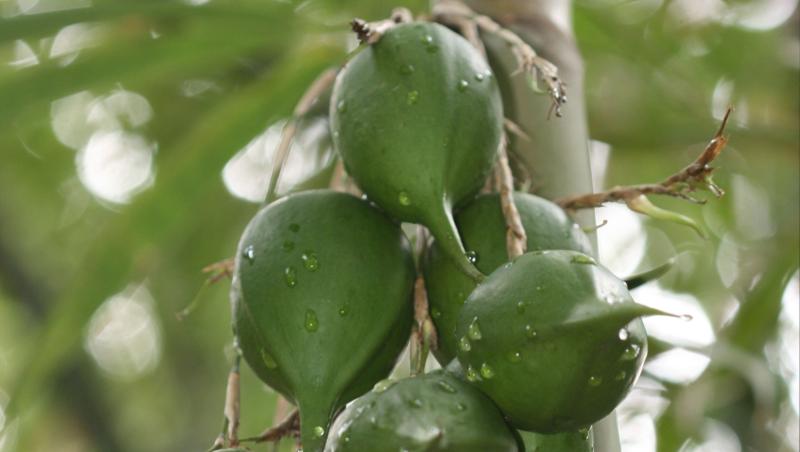
The bamboos, world’s tallest grass, are evergreen flowering plants belonging to the family Poaceae. The shoots of the plant are widely used for the construction of houses and to produce paper and pulp. In some communities, the younger and tender shoots are consumed as food. A well-known phenomenon of this versatile plant is its flowering — a spectacular sight that is seen once in many years — after which the plant dies.
Although the flowering provides an abundant supply of bamboo fruits, it brings in uninvited guests — the rush of rats. What’s in the fruit that makes it a favourite among these rodents? A study primarily by researchers at the Jawaharlal Nehru Tropical Botanic Garden and Research Institute (JNTBGRI), Kerala, tries to answer.
The researchers of the study, published in Nature Group’s Scientific Reports, have investigated the nutritional properties of the fruits belonging to the bamboo Melocanna baccifera, locally known as ‘Muli’. The research work was funded by the Science and Engineering Research Board (SERB), Department of Science and Technology, Government of India and the Plan Funded Research Programme of the Government of Kerala, India.
Muli bamboo is distributed across North East India, Nepal and Bangladesh and it flowers once in every 40-50 years. Its fruits are savoured by rodents, which feed on the grains from nearby agricultural fields post the bamboo fruiting season. In addition to the massive crop loss (which even led to famines in the past) that the rats cause, they rapidly multiply, leading to the outbreak of diseases.
“The bamboo clumps of Melocanna baccifera were introduced to JNTBGRI during 1988-1996, which flowered during 2009 to 2015 and produced attractive flowers and fruits. Since then, we have studied the nutritional aspects and the chemical compounds produced by this plant”, says Dr. Sabulal Baby, a senior scientist at JNTBGRI, in an interview with Research Matters. The current study tries to answer if the fruits of Melocanna baccifera are to be blamed for the devastation caused by the rats by conducting feeding experiments with the rats in the laboratory.
The researchers extracted, screened and identified the different compounds (phytochemicals) present in the fruits of the bamboo plant. The study revealed that they contain amino acids like lysine and glutamic acid among others, carbohydrates like glucose, fructose and sucrose, phenolic acids and about 15 types of saturated and unsaturated fatty acids. The study also found potassium to be a significant mineral content in the fruits.
Which of these chemicals attracted the rats? The feeding experiments showed that rats like to eat the liquid present in the fruit (the sap) and the seed. However, the rats could not live on the fruits alone since the experiments showed that those rats that were fed only with the fruit eventually died of insufficient energy and hypoglycemia. This result also disproves the common belief that the proteins in the fruits drove the rapid multiplication of rats.
“We found only a minimal amount of protein in M. baccifera fruits. But, previous studies had reported that the fruits are protein-rich and cited this as a reason for the multiplication of rats. We believe that the phytochemicals in the fruits are the reason for the rats’ liking for the fruit. We have definite clues and are further working on this hypothesis”, says Dr Sabulal about the findings of the study.
Another study by the reseachers found that the fruits have a high nutritional and medicinal value with rich antioxidant properties. The fruit alone is not a complete food, but when supplemented with proteins, they are valuable food additives. When consumed as a part of the regular diet, the fruit is known to prevent colon cancer, protect the body against stroke, ensure proper functioning of the cells, maintain electrolyte balance, and lower cholesterol levels.
The researchers believe that the results could potentially help in preventing and managing rodent outbreaks in areas where the bamboo is grown. Also, it can address other ecological and social problems associated with the flowering of M. baccifera like famines and disease outbreaks.
“Recent flowering of M. baccifera from 2004-‘08 occurred in 1.76 million hectares* of geographical area in the North East Indian states of Mizoram, Tripura, Manipur, Meghalaya and Assam. It resulted in the flowering and death of about 26 metric tons* of Muli bamboo. Data on the nutritional value of fruits could enhance their use by humans, and in turn, reduce its availability to rodents”, says Dr Sabulal.
*Jeeva, S.; Kiruba, S.; Lalhruaitluanga, H.; Prasad, M. N. V.; Rao, R. R. Flowering of Melocanna baccifera (Bambusaceae) in northeastern India. Current Science 96, 1165-1166 (2009).






